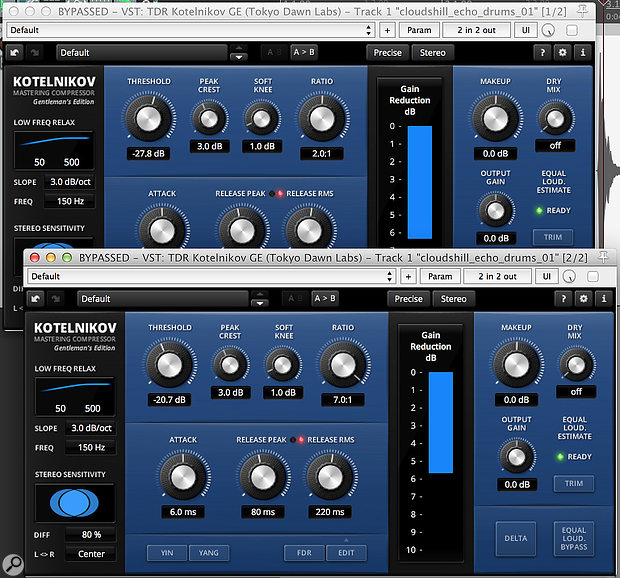 These two compressors are set with very different ratios and thresholds, but otherwise identically. They’re both knocking a maximum of about 6dB off the signal, but the results will sound very different!
These two compressors are set with very different ratios and thresholds, but otherwise identically. They’re both knocking a maximum of about 6dB off the signal, but the results will sound very different!
I’m struggling to understand what’s really happening when you use different compression ratios. For example, let’s say I take a track, duplicate it, and put one of my DAW’s stock compressors (nothing fancy) on both tracks. Then I make the Attack, Hold, and Release parameters on both compressors the same, but set the Ratio controls to 3:1 and 10:1 respectively. Now if I set the two threshold parameters so I’m achieving roughly 5-7dB average gain reduction, what’s the difference? Why does it matter that I’m using one ratio or the other? Is one ratio affecting the audio material completely differently from the other? Usually people say to use a low ratio for light compression and higher ratio for harder compression, but again if you are achieving roughly the same average level of gain reduction, what’s the difference? Should I be thinking about this in another way?
SOS Forum post
Mike Senior replies: Well, first of all, let’s clear up the simplest question. If a stock compressor is applying 6dB of gain reduction at any given moment in time, it’s unlikely to make an appreciable difference to the sound at that moment whatever ratio you’re using to achieve that gain reduction. What you see on the gain-reduction meter is, in essence, no different to someone turning down the level with a fader.
However, what’s different about compressing with different ratios is that if you’re trying to get both gain-reduction meters responding a roughly similar amount, you’ll likely have to set a higher threshold level for the higher-ratio compressor. That means that for the higher-ratio compressor you’ll see more gain-reduction on the loudest portions of the performance, and less on the quietest portions. One way you might clarify this difference in your mind is to extrapolate your example to the extreme: imagine what it would be like if you set a 1.2:1 ratio on one compressor and a 100:1 ratio on the other. For a start, it would be almost impossible to get even slightly similar gain-reduction responses for these two settings, but in addition the 100:1 ratio compressor would trigger lots of gain reduction for the loudest sections of the performance, and none at all for the quieter portions. To get the 1.2:1-ratio compressor to register 5-7dB of gain reduction you’d likely have to set the threshold below the level of the quietest portions of the performance, so you’d see gain-reduction happening all the time, but changing comparatively little for different portions of the performance.
Now to answer your last question: yes, I reckon you probably should be thinking about compression in a different way! It sounds to me as if you’re adding compression because you hear people saying you should, rather than because it’s warranted: compression is primarily a direct response to the nature of the track you’re processing. Most mix compression is little more than an automatic solution to level-balance problems. A lot of compression questions can be untangled simply by stating what the specific balance problem is, and then asking yourself what you need to do to solve it. So if I wanted to fairly gently reduce the dynamic range of a highly dynamic solo acoustic-guitar performance, I might use 5-7 dB of gain-reduction at a 1.2:1 ratio. If I wanted to apply a moderate amount of level control to a pop lead vocal while recording, without painting myself into a corner for mixdown, I might use 5-7 dB gain-reduction with a 3:1 ratio. If I wanted to control the odd overloud snare hit in an otherwise reasonably consistent performance, then I might use 5-7 dB of gain reduction at a 10:1 (or even 100:1) ratio, with the threshold set just above the level of the more consistent hits. All of these settings might trigger 5-7dB gain reduction on average, but all of these are very different settings because they’re responding to very different problems.
